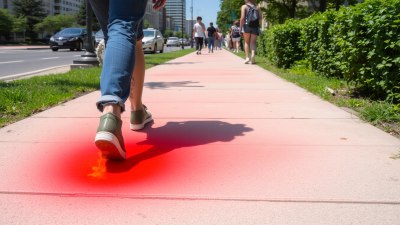What It Means When the Sidewalk Feels Like a Stove
Explore why sidewalks feel scorching hot underfoot, factors behind extreme heat on pavements, and how to stay safe.

Image created with Flux Schnell
When the sidewalk feels like a stove, many instinctively recoil from the sensation of heat so intense it seems to burn the soles of their feet. This common experience during hot summer days is more than just a quirky feeling — it reflects important environmental and physical phenomena related to temperature, urban design, and human comfort. Understanding why sidewalks get so hot provides insight into broader topics like heat waves, heat retention materials, and urban heat islands, and offers practical tips for safely navigating these scorching surfaces.
Sidewalks typically become extremely hot due to the combination of direct sunlight and the thermal properties of the materials they are made from. Most sidewalks consist of concrete or asphalt — materials known for their heat absorption and retention capabilities. These substances absorb the sun's energy throughout the day and slowly release it, which causes their surfaces to reach temperatures vastly higher than the surrounding air.
Concrete is a composite material made primarily of cement, sand, and gravel. Due to its density and color, concrete tends to absorb and store solar energy efficiently. Asphalt, often black or very dark, absorbs even more heat because dark colors draw in more sunlight rather than reflecting it. When exposed to full sun, sidewalks made of these materials can sometimes reach temperatures exceeding 140 degrees Fahrenheit (about 60 degrees Celsius), hot enough to cause discomfort or even minor burns on bare skin.
The Science Behind Sidewalk Heat
The phenomenon of a sidewalk feeling like a stove boils down to the principles of thermodynamics and heat transfer. When sunlight hits the Earth's surface, much of its energy is absorbed rather than reflected. The sidewalk then stores this heat due to its high thermal mass, gradually radiating it back into the environment, especially after sunset.
Solar radiation is divided into visible light, ultraviolet, and infrared. The infrared portion plays a crucial role in heating surfaces. Although some infrared is absorbed by the atmosphere, most of it makes direct contact with ground materials, causing their temperatures to climb. This effect is intensified in urban settings where large expanses of hard surfaces cluster together, forming what is called an urban heat island.
An urban heat island (UHI) occurs when cities experience significantly higher temperatures than surrounding rural areas. This is largely due to human infrastructure—buildings, roads, sidewalks—consisting of materials like asphalt and concrete that retain heat. The closely packed buildings and paved surfaces prevent heat dissipation and enhance heat absorption, often leading to sidewalk and road surfaces reaching dangerous temperatures during heat waves.
Impact of Sidewalk Temperature on Health and Safety
When sidewalks are extremely hot, they can pose risks to people, especially those walking barefoot or with thin footwear. Barefoot exposure to surfaces hotter than 115 degrees Fahrenheit can cause first-degree burns within minutes, and prolonged contact at even lower temperatures can create discomfort or blisters.
Children, older adults, and pets are particularly vulnerable. Babies and toddlers who crawl or play on hot surfaces risk burns, while pets’ paw pads can be damaged by similarly high sidewalk temperatures. Additionally, heat radiating from sidewalks contributes to overheating in urban environments, increasing the risk of heat exhaustion or heat stroke among residents.
Environmental and Urban Planning Factors
Several environmental and design factors influence how hot sidewalks become. The color, texture, and material composition all matter. Darker surfaces absorb more sunlight, while lighter-colored pavements reflect it, helping to reduce heat accumulation. Rough textures increase surface area exposed to sunlight, potentially increasing warming.
The placement of shade trees and vegetation near sidewalks can drastically reduce surface temperatures by blocking direct sunlight and cooling the air through transpiration. Urban planners use these strategies to counteract the UHI effect and make city landscapes more comfortable during hot days.
Climate Change and Rising Temperatures
As global temperatures continue to rise due to climate change, episodes of intense heat waves become more frequent and severe. This trend means sidewalks and other outdoor surfaces will often reach temperatures that are hazardous to health, especially in densely populated urban environments. Heat mitigation is an increasing priority in city design, encouraging the use of reflective pavements, green spaces, and innovative materials to lessen heat buildup.
Some cities have introduced cool pavement technologies, which involve altering the composition of asphalt or concrete to improve reflectivity and decrease heat absorption. Porous pavements are also being adopted to allow water to evaporate directly from the surface, using evaporation to cool the material during hot weather.
Practical Tips to Handle Hot Sidewalks
When walking during hot weather, it’s important to protect yourself from the intense heat radiating from sidewalks. Here are some practical tips:
- Wear Appropriate Footwear: Choose shoes with thick, insulating soles during hot days to protect feet from burns and discomfort.
- Walk During Cooler Times: Early morning or late evening walks avoid peak heat when sidewalks are hottest.
- Seek Shaded Routes: Opt for paths with tree coverage or awnings that provide shade and reduce ground temperature.
- Stay Hydrated: Hot conditions and prolonged outdoor exposure increase dehydration risk, so drink plenty of water.
- Use Water Sprays: Spraying water on pavement can cool the surface temporarily, though evaporation causes this effect to be short-lived.
- Limit Barefoot Walking: Avoid direct contact of bare feet with sidewalks during hot weather to prevent burns.
Innovations to Cool Sidewalks
Researchers and engineers are exploring new materials and designs to address the problem of overheated sidewalks. Some innovations include:
- Reflective Coatings: Applying special paints or sealants that reflect sunlight reduces heat absorption dramatically.
- Permeable Pavements: These allow water to pass through and evaporate, cooling the surface naturally.
- Light-Colored Concrete Mixes: Using lighter aggregates and additives alters the color and thermal properties to lower heat retention.
- Green Infrastructure Integration: Combining sidewalks with integrated vegetation or installing green walls beside paths.
These forward-thinking strategies aim to reduce the urban heat island effect and improve comfort and safety for pedestrians.
Psychological and Sensory Perception of Heat
The sensation of a sidewalk feeling like a stove is not just physical but also sensory. Human skin contains thermoreceptors that help detect temperature and intensity. When stepping on a scorching surface, the nerve endings send urgent signals to the brain indicating danger, prompting immediate withdrawal and protective behaviors.
This sensory input fires a response that can influence behavior and mood, making people feel anxious or irritated in extreme heat. It also affects choices like the type of shoes worn or the decision to avoid certain outdoor activities during the hottest hours.
Historical Context of Heat-Absorbing Surfaces
The urban heat island effect and hot sidewalks became more prominent as cities grew and replaced natural landscapes with concrete and asphalt. Early cities had dirt roads and cobblestones that absorbed less heat but were replaced in the 20th century with smooth, dark surfaces which increased heat retention. Recognizing this, urban planners and architects increasingly emphasize sustainable designs to counteract these effects while maintaining functional roads and sidewalks.
Traditional design practices across cultures have used reflective materials and open-air layouts to reduce heat in pedestrian areas. Some desert cities use light-colored stones or tiles that stay cooler under direct sunlight.
Educational and Community Efforts
Communities and local governments are raising awareness about the dangers of hot sidewalks and heat exposure. Educational campaigns provide information on heat safety, signs of heat illness, and preventive strategies, especially during summer months and heat advisories. Schools teach children about the importance of hydration and protective footwear, and community programs often distribute cooling kits or shade structures in public spaces.
Emergency services prepare for increased medical incidents during heat waves, and urban planners incorporate heat management into infrastructure improvements. These interventions aim to protect vulnerable populations and enhance quality of life in hot environments.
Broader Implications of Sidewalk Heat
The intense heat of sidewalks also relates to wider societal interests such as energy consumption and environmental justice. Increased urban temperatures drive higher demand for air conditioning, contributing to energy use and greenhouse gas emissions. Low-income neighborhoods often have fewer trees and more paved surfaces, leading to greater heat risks and health disparities.
Addressing hot sidewalks is thus part of a holistic approach to creating sustainable, equitable cities. By investing in green infrastructure, innovative materials, and public education, communities can reduce heat exposure and its negative impacts.
Ultimately, the feeling of a sidewalk that resembles a stove is a tangible reminder of the intersection between natural forces, human activity, and the built environment. It calls attention to the need for thoughtful solutions that balance urban growth with climate resilience and public well-being.











